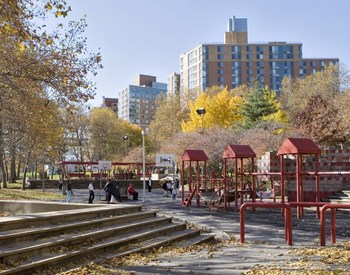
A two-mile long sliver of land in the East River between Manhattan and Queens, Roosevelt Island sits a mere 700 feet from Manhattan’s East Side. Still, many New Yorkers know nothing about Roosevelt Island’s expansive green spaces and unrivaled city views, not to mention the distinctive small town ambiance of this planned community.
“In a big city where people complain about isolation, Roosevelt Island is a stunning exception,” said Dick Lutz, editor of The Main Street WIRE and an island resident since 1981. “Here, you can’t walk an eighth of a mile to the supermarket without stopping four or five times to chat with someone you know.”
An Island of Many Names
Roosevelt Island was not always a residential community, and its varied history is reflected in the plethora of names it has carried through the years.
Once called Minnahononck by the Algonquin Indian inhabitants, the island was purchased in 1637 by the Dutch, who renamed it Varckens Eylandt or Hogs Island. In the 1660s, the British claimed and granted the land to Captain John Manning, the sheriff of New York. The island then became known as Manning Island. When Manning died in 1686, his stepdaughter renamed the island after her husband Robert Blackwell. Blackwell Island remained that family’s “country” getaway until 1828, when the City of New York bought it for $32,500 to house a penitentiary. This began the most storied chapter of the island’s history.
Soon the penitentiary was joined by the New York Lunatic Asylum and the Smallpox Hospital. The asylum was destroyed by fire in 1858 and rebuilt for $150,000 some years later. Actress Mae West was sentenced and served a ten-day jail term here for appearing in her play “Sex.” Noted journalist Nellie Bly famously faked mental illness and spent ten days in the insane asylum, which she described as “a human rat-trap.” As Blackwell Island came to have a connotation worse than today’s Rikers Island, city officials sought a new name after deciding to transform the location into a hospital complex. In 1921, it was christened Welfare Island.
In 1935, the penitentiary on Rikers Island opened, and the Welfare Island convicts were moved to the new facility. During this time, the island’s psychiatric facilities were emptied through a widespread process of de-institutionalization. By 1968, Welfare Island was occupied by only two hospitals and a city fire department training center. Mayor John Lindsay organized a committee to explore the future of the island, and a residential community was proposed.
New York State’s Urban Development Corporation took a 99-year lease on the land, and architects John Burgee and Philip Johnson created a three-phase plan, which envisioned the creation of 5,000 apartments housing 20,000 people. Under the political jurisdiction of Manhattan, the community would receive police, sanitation and fire services from Queens.
By now Welfare Island had developed its own negative associations. In an effort to make the island more attractive to prospective residents, the island was rebranded once more in 1973. The name Roosevelt Island came from an anticipated monument honoring President Franklin D. Roosevelt, but the memorial was never completed due to the untimely death of architect Louis Kahn. Some still hope to see a Roosevelt memorial built on the island, though one was constructed in 1997 in Washington, D.C.
The Residential Rebirth
The first phase of Roosevelt Island’s residential development, called Northtown, consisted of a series of four high-rise buildings. The project was finished in the mid-1970s. Today, Northtown’s Eastwood building is still rental, but no longer part of the Mitchell-Lama housing program. Island House and Westview are market-rate rentals, and Rivercross is a Mitchell-Lama co-op working toward privatization.
In 1984, construction began further north on a cluster of four high-rises called Manhattan Park. All buildings contain market-rate rentals except one reserved for Section 8 subsidies.
Burgee and Johnson knew that Roosevelt Island residents would need more than just housing. They would also need reliable transportation into the city. As part of Burgee and Johnson’s plan, tramway service connected Roosevelt Island to 60th Street and Second Avenue in Manhattan in 1976. In 1989, the F train also began servicing the island and MTA bus service runs between Astoria and the island.
The final phase of Roosevelt Island’s residential development, called Southtown, entailed nine additional high-rises. Construction began in 1998 and continues today. The first two buildings were sold to Memorial Sloan-Kettering Cancer Center and the New York-Presbyterian Hospital/Weill Cornell Medical Center, which rents the apartments to their employees.
The third building, Riverwalk Place, opened in 2004 as the island’s first luxury condo. It features Manhattan-like amenities such as a fitness center, playroom, rooftop lounges, landscaped sundeck, bicycle room and storage lockers. Apartments boast floor-to-ceiling windows with city views, marble baths and hardwood plank flooring. A one-bedroom is currently listed through Prudential for $599,000.
Adjacent to Riverwalk Place is building four, Riverwalk Landing, which opened in 2006 with both market-rate and subsidized rentals. Nearby Riverwalk Court, building five, is a 123-unit condo currently under construction, as a joint venture between related companies and The Hudson Companies. When it opens this spring, its residents will enjoy rooftop cabanas, a fitness center and yoga studio, a children’s playroom and entertainment lounge. One-bedrooms are available for $575,000 to $662,500. Two-bedrooms are listed from $750,000 to $1,065,000.
Riverwalk Crossing, is nearing completion as well. Its units and rentals, will likely go on the market this spring. Southtown’s final three high-rises are still “a glimmer in our eye,” said David Kramer, a principal at The Hudson Companies Inc. in Manhattan, the developer of Southtown. They will likely be a mix of rentals, co-ops and condos, as well as some affordable housing, Kramer said.
In addition to new buildings, “the Octagon,” a part of the New York Lunatic Asylum, was restored and reopened in 2006 as luxury rentals. With a green building design, tennis courts and a waterfront pool, it has perhaps attracted the most affluent residents to Roosevelt Island. Studios start at $1,800, one-bedrooms at $2,325 and two-bedrooms at $3,150.
Although no plans are currently in the works for the Octagon to turn co-op or condo, general manager Barbara Clark says that may be something the building looks to do in the future. She also notes that the Octagon is open to long-term leases. On average, market-rate prices on Roosevelt Island are 20 to 30 percent lower than comparable apartments in Manhattan. Discounts like these have drawn many to the community.
“It’s so much closer to Midtown than say Astoria, and the price is on the same level,” said Ashley Halpin, who rents a one-bedroom in Manhattan Park.
Bright Lights, Small Community
Roosevelt Island residents are proud that their high-rises rival the ones whose lights are seen shining across the river, but they also appreciate what distinguishes their community from the bustling city.
The island’s proximity to the United Nations draws many foreign diplomats. Signs on lampposts welcome visitors in seven languages, and, according to Lutz, “you’ll hear more languages here than anywhere else in the world, except the U.N. itself.”
In fact, the 2000 census reported that the community was quite diverse: 45 percent white, 27 percent black, 14 percent Hispanic and 11 percent Asian. The island’s affordable housing programs ensure a variety of income levels too.
The plethora of playgrounds, parks and sports fields also makes Roosevelt Island an ideal place for families. Kids don’t have to cross the river for school, as P.S. 217 and I.S. 217 are on the island. There’s a Little League and a swim team, and children can walk down the street to the Grandpa Al Lewis Playground without adults. The island’s seclusion affords families a sense of security unmatched elsewhere in New York City.
Roosevelt Island is both blessed and limited by this insular nature, however. Halpin, who moved to the community four-years ago after finishing college, says her one complaint is the island’s lack of retail and entertainment, particularly for young professionals.
“Though the East Side [of Manhattan] is only a tram ride away,” she added, “it doesn’t bother me so much.”
Southtown’s development has brought some retail business, such as a Starbucks and a Duane Reade as well as restaurants Nonno’s Foccaceria and Fiji East. Main Street’s small commercial strip offers a post office and public library as well as a thrift store, grocery, nail salon and liquor store.
What the neighborhood lacks in amenities, though, it makes up for in character. There are few cars on Roosevelt Island; bright red shuttle buses transport residents for the nominal fare of only a quarter. They can join the community theater, garden club or any of the dozens of other active organizations. And where else in the city does Main Street shut down for a parade on the opening day of the Little League season?
In many ways, Roosevelt Island offers residents the best of both worlds.
Lutz originally moved to the island because of its nearness to what he considers to be the greatest city in the world. He has been delighted by the unexpected bonus of living in what he calls “the greatest little community in the world.”
What’s Next for Roosevelt Island?
In 2000, Roosevelt Island had fewer than 10,000 residents. Since then, more than a thousand new apartments have risen or are rising, and Steve Shane, president & chief executive officer of the Roosevelt Island Operating Corporation, estimates that the island today houses 14,000 people.
When asked where Roosevelt Island is headed, Shane laughs, “Nowhere. It’s staying right where it is in the East River.”
He’s joking, of course, but he does have a point.
While growing in presence and popularity—not to mention in price—Roosevelt Island will always be a two-mile long sliver of land. Even when the final phase of development is complete, Shane estimates that the island will house no more than 18,000 people. This is compared to the almost 240,000 people living across the river on Manhattan’s Upper East Side. How buildings seven, eight and nine will change the face of Roosevelt Island remains to be seen
But one thing is certain: Roosevelt Island, with all of its charm, will still be a small community close to the big city.
Alexis Wolff is a freelance writer living in Brooklyn.






Leave a Comment